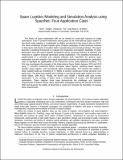Space Logistics Modeling and Simulation Analysis using SpaceNet: Four Application Cases
Author(s)
Grogan, Paul Thomas; Yue, Howard K.; de Weck, Olivier L.
Downloadde Weck_Space logistics.pdf (880.9Kb)
OPEN_ACCESS_POLICY
Open Access Policy
Creative Commons Attribution-Noncommercial-Share Alike
Terms of use
Metadata
Show full item recordAbstract
The future of space exploration will not be limited to sortie-style missions to single destinations. Even in present exploration taking place at the International Space Station in low-Earth orbit, logistics is complicated by flights arriving from five launch sites on Earth. The future challenges of space logistics given complex campaigns of interconnected missions in deep space will require innovative tools to aid planning and conceptual design. This paper presents a modeling framework to evaluate the propulsive and logistics feasibility of space exploration from the macro-logistics perspective, which covers the delivery of elements and resources to support demands generated during exploration. The modeling framework is implemented in a versatile and unifying software tool, SpaceNet, for general space exploration scenario analysis. Four space exploration scenarios are presented as application cases to highlight the applicability of the framework across vastly different scenarios. The first case investigates the resupply of the International Space Station between 2010 and 2015 using 77 missions combining NASA, European Space Agency, Japanese Space Agency, Russian Space Agency, and commercial space transportation. The second case models a lunar outpost build-up consisting of 17 flights to achieve continuous human presence over eight years. The third case models and evaluates a conceptual sortie-style mission to a near-Earth object, 1999 AO10. Finally, the fourth case models a flexible path type human exploration in the vicinity of Mars using a combination of human and tele-operated exploration. Taken together these cases demonstrate the challenges and logistical requirements of future human space exploration campaigns during the period from 2010-2050 and illustrate the ability of SpaceNet to model and simulate the feasibility of meeting these requirements.
Date issued
2011-09Department
Massachusetts Institute of Technology. Department of Aeronautics and Astronautics; Massachusetts Institute of Technology. Engineering Systems DivisionJournal
Proceedings of the AIAA SPACE 2011 Conference & Exposition
Publisher
American Institute of Aeronautics and Astronautics
Citation
Grogan, Paul, Howard Yue, and Olivier De Weck. “Space Logistics Modeling and Simulation Analysis using SpaceNet: Four Application Cases.” In AIAA SPACE 2011 Conference & Exposition. American Institute of Aeronautics and Astronautics, 2011.
Version: Author's final manuscript
ISBN
978-1-60086-953-2